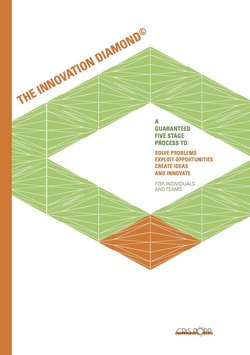Читать книгу Innovation Diamond - Cris Popp - Страница 4
На сайте Литреса книга снята с продажи.
ОглавлениеTHE INNOVATIVE ORGANISATION
While you can’t just ‘command’ your people to be innovative, you can create a productive, creative culture, remove impediments and build structures and processes to aid innovation. Chief amongst these is a clear model for ‘ideation’ - how do you develop an idea from initial concept to project start-up? The Innovation Diamond©, is such a model. It is highly intuitive and clients have found it to be very effective.
You also need a way to “encourage, collect, and vet ideas”, good leadership, a supportive climate, networks, external scanning and ways to measure your success and keep on track.
NINE ASPECTS OF AN INNOVATIVE ORGANISATION
1.‘Ideation’ — a clear process for developing ideas, such as The Innovation Diamond© (ID).
2.Reward and recognition that encourages ideas.
3.A process for collecting and vetting ideas.
4.A framework for managing resources and prioritising projects.
5.Leadership — setting a strategic vision and encouraging innovations around that vision. Treating mistakes as learning opportunities, empowering staff.
6.A supportive climate — flexibility, a culture that encourages experimentation, teamwork and diversity and gives appropriate rewards, training and tools.
7.Coherent strategies that don’t impede innovation.
8.External scanning — seeking and responding to opportunities and stimulus in the external environment.
9.Measure and maintain — tracking progress and improving the stream of ideas and the innovation process.
STRATEGY
It is clear that organisations that succeed with innovation, have clear and deliberate strategies. Why does this make a difference? Because one of the biggest impediments to innovation is ‘business-as-usual (BAU)’. In my 15 years of working with organisations around innovation, a consistent reason for not being innovative is that business-as-usual gets in the way. The daily pressure, to produce goods and services, to ‘get things done’ interferes with the opportunity for innovation.
Without a deliberate strategy, innovation will be subsumed by day-to-day operations.
The way to clear space for innovation is to have a deliberate strategy and make it an organisational priority. The strategy should include the points above plus a few extra. Your strategy needs to be developed, with input of all levels and areas within your organisation, in an environment of free and frank conversation, preferably facilitated by an external consultant with expertise in the area. Allow about three days for the essential elements.
If you would like a copy of our paper “10 Must Haves for Your Innovation Strategy” please write to us at info@crispopp.com
HOW THE INNOVATION DIAMOND© (ID) FITS IN
Believe it or not, you will always have more ideas, than resources to implement them. You can’t develop every idea, and often the first idea isn’t the best one. You want to be able to develop an idea as far as possible, before you start investing money, time and reputation. You also want to make sure that you’re solving the right problem.
The Innovation Diamond© helps to ensure you are solving the right problem or taking advantage of the best opportunity. It ensures that you fully understand the issue, and that you have developed, and considered a wide range of solutions. It also helps you to combine a number of good ideas into one success.
In short, The Innovation Diamond© helps you hone your ideas before the more expensive prototyping and implementation stages. It will help you and your team feel confident working with new ideas, and will give the executive a measure of comfort in your proposals — crucial to obtaining the resources and funding you’ll need to turn your idea into a successful reality.
USING THIS MANUAL
This manual is a ‘how-to’ guide to The Innovation Diamond© (ID). There are five stages in all — four on “ideation” which this manual covers in detail, and one on project management, which can be covered by your usual project processes.
The manual, and ID, can be used on an individual basis — that is working on your own — or to run a group workshop.
The manual takes you through each stage of the ID with tools and worked examples, plus hints for running workshops and guidance on behaviours that support innovation. It can be read from start to finish or used as a quick reference.
Being innovative is not about sitting around and having ‘whacky’ ideas. Even if it were, you would still need to refine and ‘harvest’ them. Research has shown that innovative organisations have processes for the inspiration, harvesting and development of ideas (this is called ‘ideation’).
The Innovation Diamond© (ID) is such an ideation process. Each stage of the ID has a different purpose and different tools associated with it.
In the same way that real diamonds are formed by subjecting common carbon to intense heat and pressure, the ID subjects common issues to the heat and pressure of creativity to develop sparkling new concepts.
